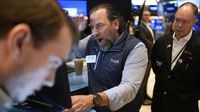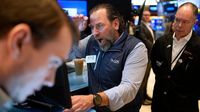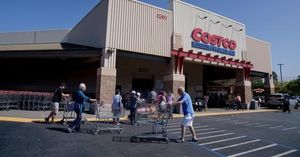On April 4, 2025, U.S. stocks faced a dramatic sell-off that echoed the financial turmoil witnessed during the COVID-19 pandemic, as fears of an escalating trade war between the United States and China gripped investors. The Dow Jones Industrial Average plummeted more than 1,600 points, or 4%, while the S&P 500 and Nasdaq Composite fell by 4.7% and 5.3%, respectively. This market upheaval came on the heels of China announcing retaliatory tariffs of 34% on all U.S. goods, a move that intensified concerns about the potential for a global economic downturn.
The turmoil began after President Donald Trump announced a sweeping set of tariffs earlier in the week, which included a minimum tariff of 10% on imports, with significantly higher rates on products from China and the European Union. According to UBS, these tariffs could reduce U.S. economic growth by 2 percentage points this year and raise inflation to nearly 5%. Following this announcement, the S&P 500 fell 4.8%, marking its worst day since the pandemic-induced crash in 2020.
As the stock market reacted to the news, investors faced a stark realization: the potential for a recession loomed large. JPMorgan analysts indicated that both the U.S. and global economies had a 60% chance of entering a recession this year, particularly if retaliatory measures continued to escalate. Despite the fear gripping the markets, a report released on the same day showed that U.S. employers added 228,000 jobs in March, exceeding expectations. However, the positive job growth was overshadowed by the anxiety surrounding tariffs.
"Unfortunately, the market is no longer focused on the jobs market and focused squarely on tariffs and trade wars as the U.S. plays chicken with the rest of the world," said Chris Zaccarelli, chief investment officer at Northlight Asset Management.
In the wake of the tariffs, stocks across various sectors took significant hits. Companies with extensive ties to China were particularly hard hit; for instance, GE Healthcare saw its shares drop by 17.9%, while United Airlines fell 8.1% due to concerns over decreased travel demand. The tech sector was also affected, with major players like Apple and Amazon experiencing substantial declines. Apple shares dropped by 4% on April 4, following a 9% decrease the previous day.
The market's reaction was not limited to U.S. stocks. Global markets also felt the impact, with European stocks dropping more than 3% and Asian indexes following suit. The price of crude oil fell sharply, with U.S. oil plunging nearly 9% to below $62 a barrel, reflecting fears of diminished global demand.
As the situation unfolded, President Trump remained optimistic, asserting that his policies would ultimately benefit the economy. He stated, "To the many investors coming into the United States and investing massive amounts of money, my policies will never change. This is a great time to get rich, richer than ever before!!!" However, many analysts viewed the situation differently, suggesting that the tariffs could lead to prolonged economic instability.
Market sentiment was further complicated by the Federal Reserve's potential reaction to the crisis. Analysts speculated that the Fed might consider cutting interest rates to support the economy, which could help ease some of the burdens on businesses and consumers. The yield on the 10-year Treasury fell to 3.92%, down from approximately 4.80% earlier in the year, indicating growing concerns about economic health.
Trump's administration has framed the tariffs as a means to restore competitive balance and bring manufacturing jobs back to the U.S. However, the speed and depth of these policies have raised alarms among economists who warn that they could stoke inflation and dampen demand, potentially tipping the global economy into recession.
As the trading day progressed, the Dow entered correction territory, with its 10% decline from recent highs solidifying concerns among investors. The S&P 500 and Nasdaq also faced significant losses, with the latter entering bear market territory after falling more than 20% from its peak.
In summary, the events of April 4, 2025, marked a critical juncture in the ongoing trade war between the U.S. and China. As both nations continued to impose tariffs on each other's goods, the implications for the global economy became increasingly dire. Investors, analysts, and policymakers alike will be closely monitoring developments in the coming weeks, as the potential for further escalation looms large.









